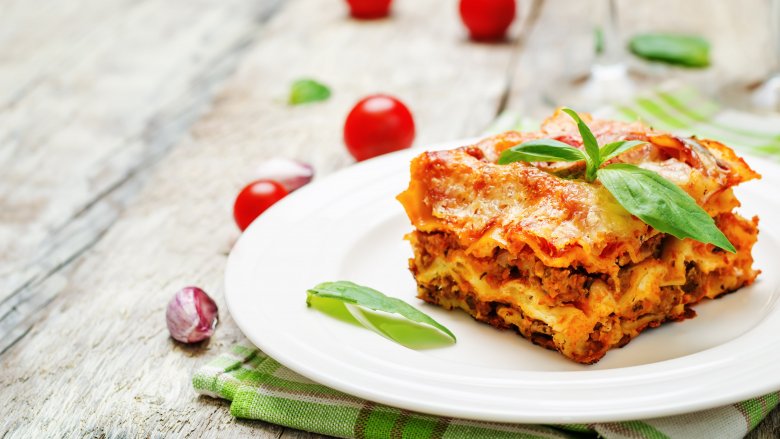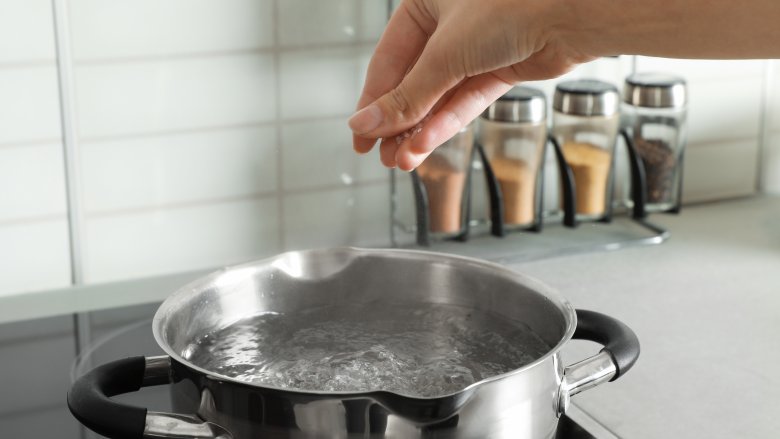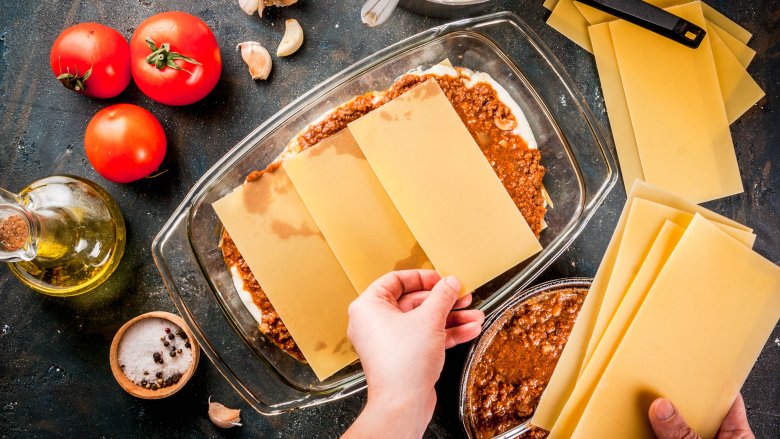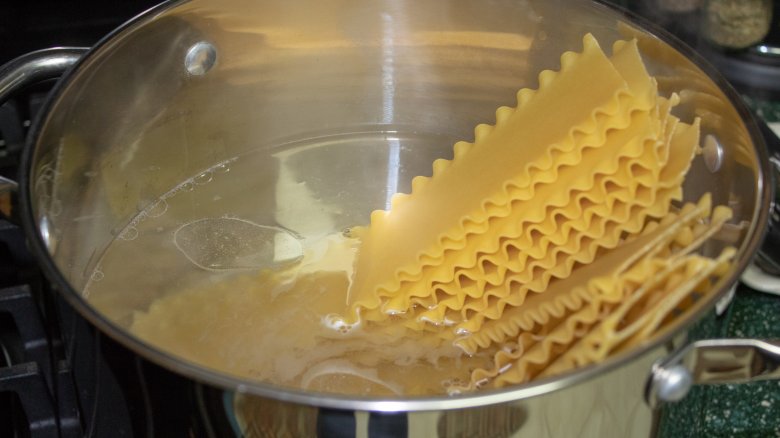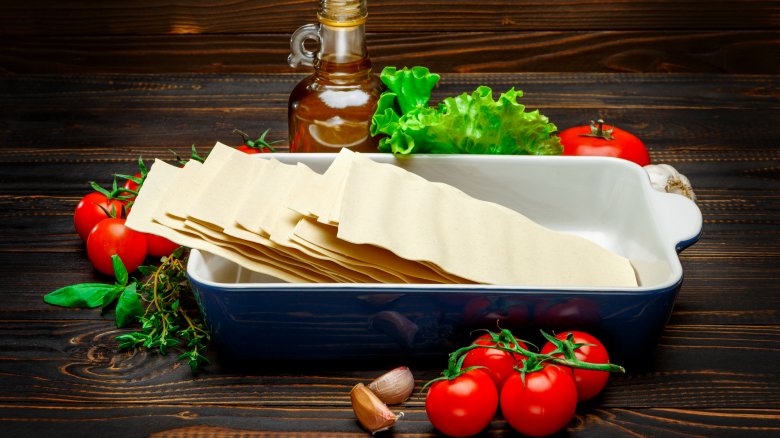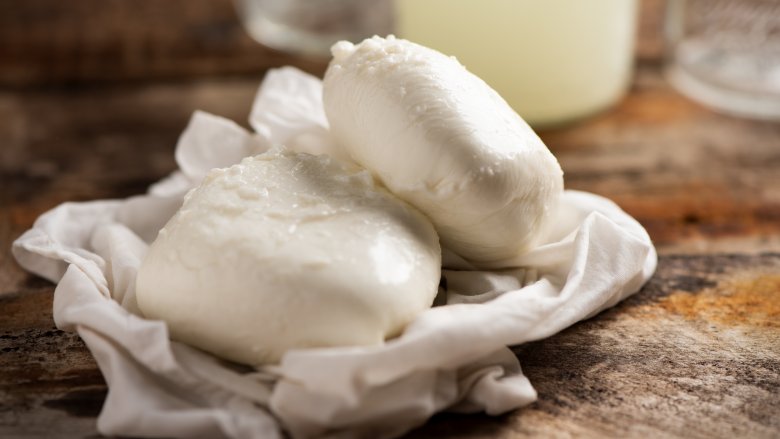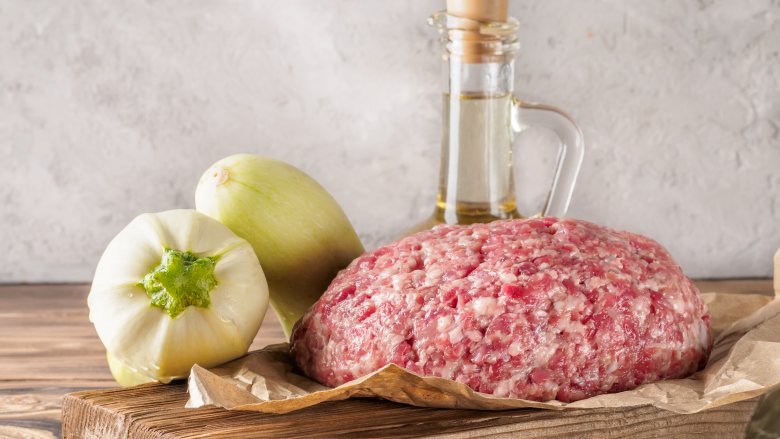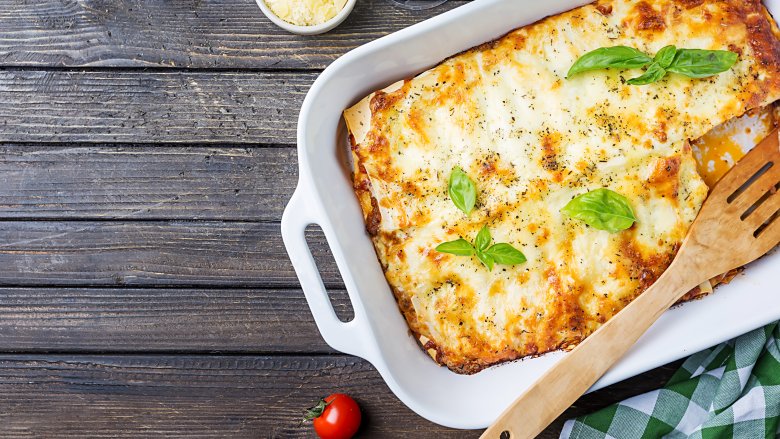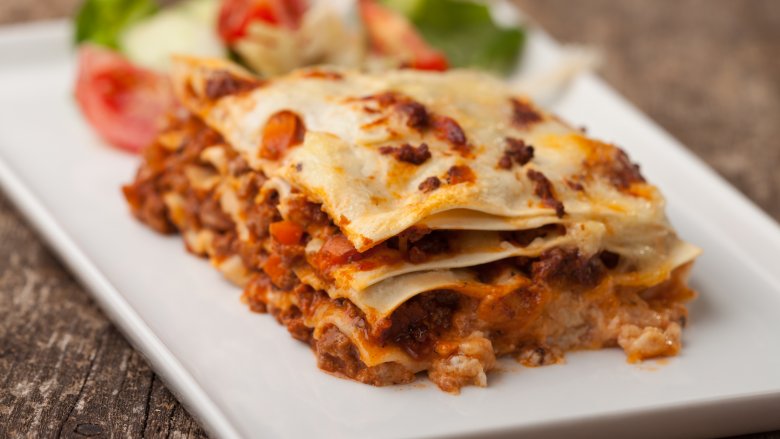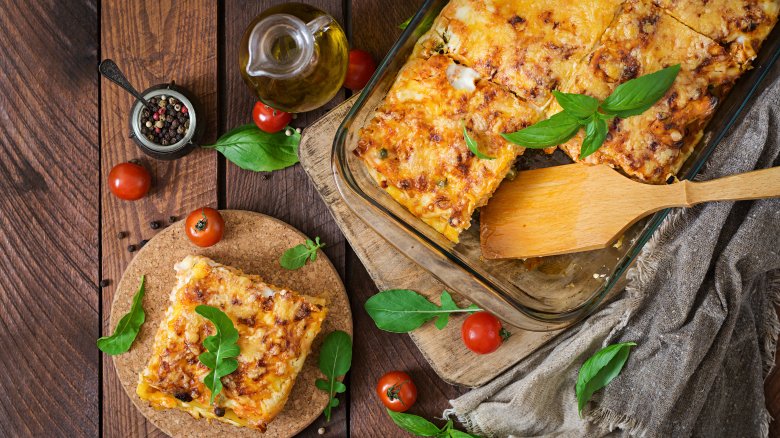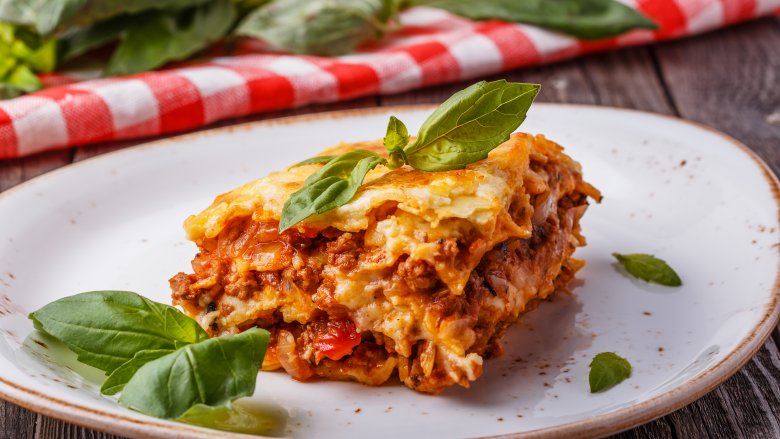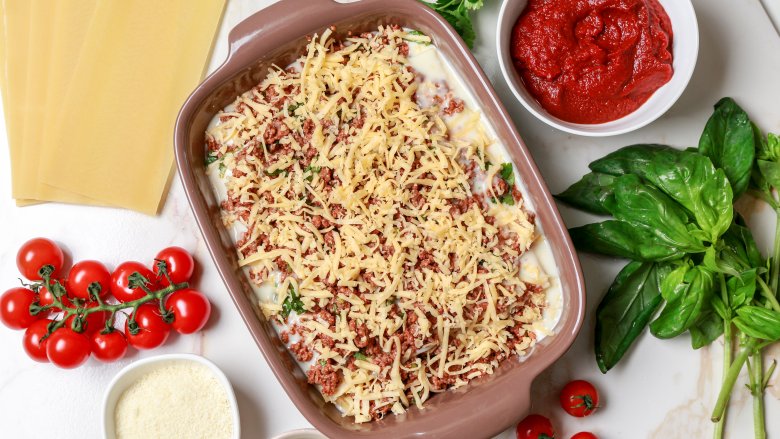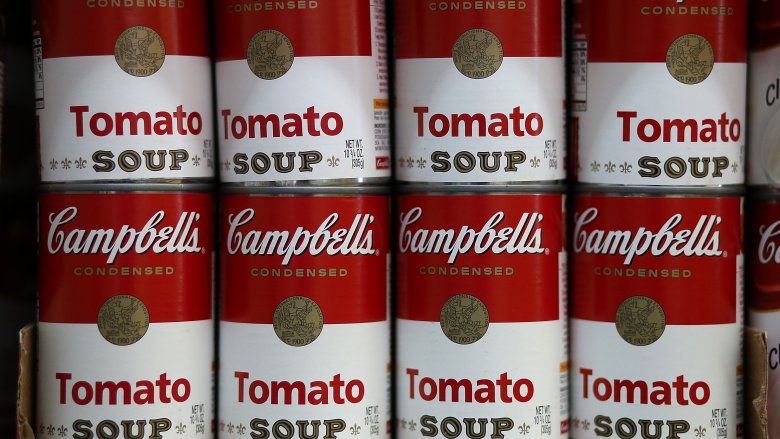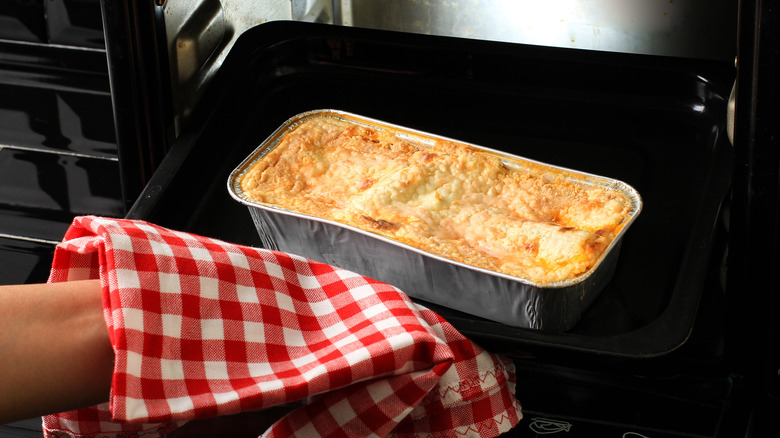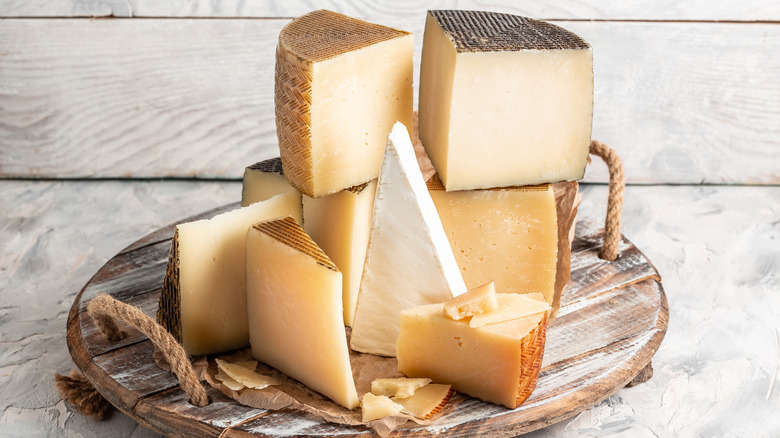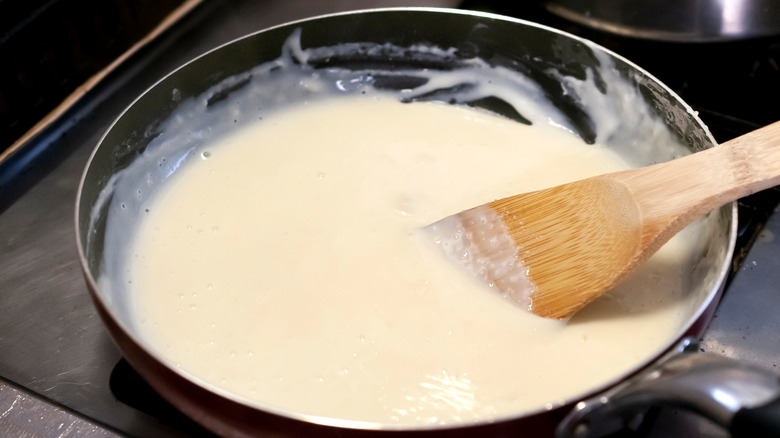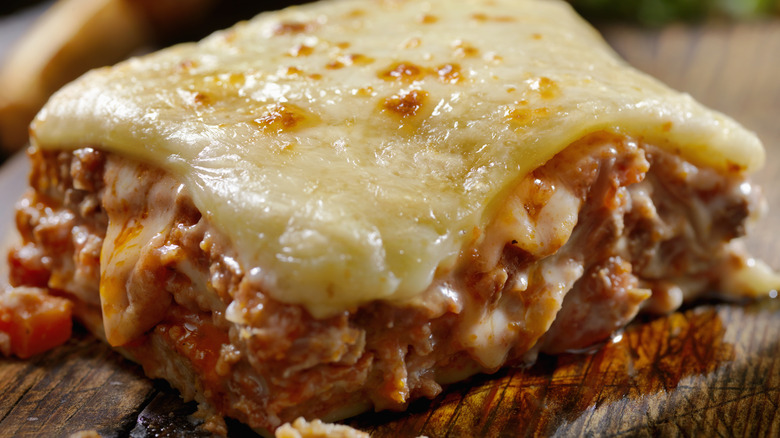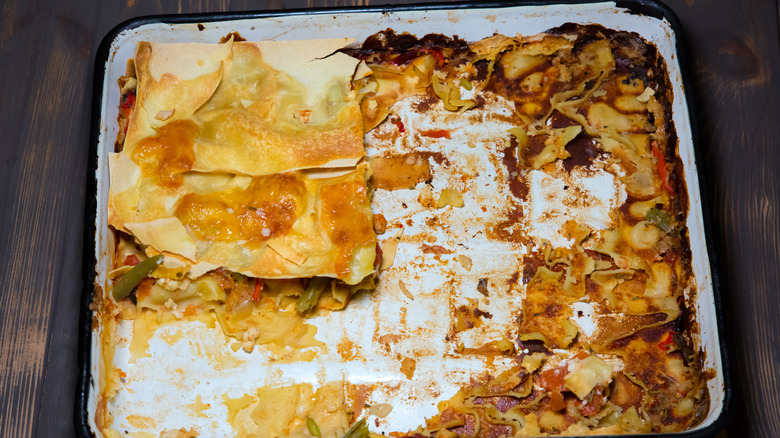17 Common Lasagna Mistakes Everyone Makes
There are certain pasta dishes that are a total breeze to throw together. A basic pomodoro or a quick carbonara can come together inside of 30 minutes, and if, worst case, you have a total recipe fail on your hands, it's not the disaster that a more involved pasta dish would be — say a lasagna. Because when you've only committed a few ounces of spaghetti and a handful of sauce ingredients, a simple pasta dinner that doesn't work out isn't the end of the world, even if its final resting place is the garbage can. But an entire casserole dish stuffed to the brim with layers of meat, cheese, sauce, and noodles that comes out inedible? That's enough to make a grown man cry, and most of us would choke down even the most miserable of lasagnas to avoid dumping it.
The good news is that even the biggest lasagna-ruining mistakes are easy to avoid, once you know what they are. By abiding by a few simple rules, you'll never again pull a mushy, soupy, crunchy casserole disaster from the oven. You're welcome.
1. You're not salting the water
This is Pasta 101: Just like you would with your spaghetti and your penne, you've got to salt the water when you boil your lasagna noodles. It doesn't matter if those noodles are going to be surrounded by the most flavorful mixture of meat and sauce that's ever been whipped up. It doesn't matter how divinely salty the Parmesan cheese is. If you don't salt the water that the noodles cook in, you recipe is kind of doomed from the start.
That's because on its own, pasta is actually pretty boring in the flavor department. How exciting can plain ol' flour and water really be? But by salting the water before adding the pasta, the noodles will absorb that flavor as they cook, and become seasoned throughout. Bon Appétit recommends 2 tablespoons of kosher salt for every 4 quarts of water, and though that might seem like a lot, you have to remember that the pasta isn't absorbing all of that salt.
The result will be lasagna noodles that actually taste good, and once they're layered with all that meat and cheese and sauce, you'll rest easy knowing that there isn't one component in your dish that's bland — each layer can shine on its own.
2. You're assembling it wrong
Assembling lasagna can be a bit of a chore with all those layers and all those ingredients. But it turns out there are a few ways that you can make things a lot easier on yourself — it's all about assembling it in the correct order.
Before you roll your eyes and continue your haphazard lasagna prep, answer these questions: Does your bottom layer of noodles always stick to the pan? Do you find it challenging to spread the filling evenly over the sauce? If you answered yes to either, you need this tip.
For starters, Sabrina Sexton, culinary arts program director at the Institute of Culinary Education in New York City, told Today, "The secret to a perfect lasagna is to always use equal parts of lasagna noodles, sauce and whatever other filling you want to use." Aside from that, she says, it's important to follow this order of assembly: "Sauce, noodle, filling, repeat."
"The filling should always go straight on top of the noodle because it is easier to spread," Sexton explained. "If you put sauce on the noodle first, the filling will be very difficult to spread." And one more smart piece of advice: Always put a little sauce down on the bottom of the pan before your first layer of noodles to prevent sticking.
3. You're mistreating your noodles
We've all been there — the lasagna noodles are done, but your timing is off and you're not ready to start assembling. You can't leave them in the water to keep cooking, so you dump them in the colander while you finish up, only to discover one massive clump of pasta by the time you're ready for them. It's hard to time these things just right, though, so what do you do?
First things first, you have to be sure not to overcook your noodles, warns Bon Appétit. Associate food editor Rick Martinez recommends boiling for just 4 to 5 minutes (because don't forget, they'll be hanging out in the oven for some time, and mushy noodles are nobody's favorite part of a lasagna). Once they're perfectly cooked, drain the noodles and avoid the clump factor by placing each one flat on an oiled baking sheet. This will buy you a little time, there's no danger of the noodles sticking together, and the oil will keep them just slightly moist.
If that sounds like way too much work and way too many extra dishes, Lifehacker has an easier option: After draining, toss the noodles with just enough of the sauce to coat — sort of like dunking the tortillas in sauce when you make enchiladas. That will keep everything lubricated and clump-free.
4. You're not using no-boil noodles
Let's be honest — although super simple to do, the extra step of boiling pasta can be the thing that pushes lasagna from doable weeknight meal to Sunday dinner only, when you've got ample time to spend in the kitchen. Enter no-boil noodles, your weeknight lasagna savior. But isn't that cheating, you wonder? Lasagna purists might say "no way" to this shortcut, but Epicurious' Adina Steiman says "yes way," and not just because they're easier (but they definitely are).
Steiman sings the praises of the no-boil noodle option, saying "they're actually way more delicious than the regular, frilly-edged kind you have to cook before using." That's because, she explains, since they have to cook through in short order, they're a lot thinner than traditional dried lasagna noodles, and it's that thinness, which is closer to the texture of homemade pasta, that provides a more delicate and tender mouthfeel. We're sold.
One thing to keep in mind, Steiman notes, is that since the noodles go in dry, there needs to be plenty of sauce for them to soak up, and every last bit of surface area needs to be coated. Nobody wants to bite into a crunchy lasagna.
5. You're not using fresh mozzarella
Lasagna is only as good as the sum of its parts, so it's essential that each and every one of those parts be utterly delicious. With that in mind, it's time to rethink your stance on the kind of mozzarella you're using.
Sure, it's easy to grab a bag of pre-shredded part-skim mozzarella, and besides that, it is what most recipes call for anyway. Who are you to buck tradition? But, according to Epicurious, if you don't use fresh mozzarella you're missing a chance to add a richer dairy flavor to your lasagna that the shredded cheese doesn't offer. Better flavor notwithstanding, the fresh stuff also amps things up in the texture department, because although part-skim mozzarella is known for its melting abilities, it can seem to sort of melt its way into ambiguity.
If you've dipped your toes into the fresh mozzarella pool in the past and are worried about the cheese's higher water content turning your lasagna into soup, you can combat that by draining slices on paper towels for about 15 minutes before adding it to your dish.
6. You're using the wrong meat
If you stick to the status quo, you'll just keep making the same ol' meat lasagna with ground beef that you've been making for years. Maybe it's the recipe that your grandma handed down to you, and you just couldn't think of straying from the tried-and-true family favorite. Do yourself a favor — while Grandma's not looking, change up that meat. She'll probably like it even better than her original version.
As Allrecipes bluntly puts it: "All-beef is not best." It might work for your basic spaghetti in meat sauce, but with lasagna, pork reigns supreme, or more particularly, Italian sausage. That's because the sweeter and fattier pork sausage provides a finer texture than ground beef, says The Seattle Times, and is the preferred meat in Italian ragùs. If you just can't break with tradition completely, at least substitute half the beef with pork. Once you see how good that is, you'll likely make the leap to full sausage.
For even more meaty goodness, Taste of Home's Stephanie Marchese takes a different approach. "The more sausage the better, so I use both bulk and link," she says. "The bulk sausage adds depth and richness to the sauce, which our family calls sugu. I slice the links and add slices between the layers of noodles to provide a big burst of flavor."
7. You're using the wrong pan
Glass? Metal? Does it really matter when it comes to baking lasagna? It turns out it does.
Bust out that trusty old Pyrex dish, because glass is the way to go. Top Rated Kitchen explains that although glass doesn't heat up as quickly or conduct heat as well as metal, it does distribute heat better, and bonus, it'll stay warm longer once it's out of the oven. Metal pans, they say, can react with the acidity of ingredients like tomato sauce and add an undesirable metal taste to the food. (If you do choose metal your best bet is stainless steel, which won't react like cast iron or aluminum will.)
When it comes to size, there's only one right choice according to Michael Symon. The celeb chef dished out his best lasagna-making tips to Food & Wine, some of them borrowed from his mother, who, he says, happens to make the best lasagna he's ever eaten (and he's eaten a lot). The pan has got to be 9 x 13, Symon says, because "it keeps the ingredients condensed so the final product is nice and thick, versus each layer being spread thinly in a larger pan." Lucky for all of us would-be lasagna makers — the classic 9 x 13 Pyrex casserole dish is a staple in most of our kitchens.
8. You're not combatting soupiness
Lasagna soup? Sure, sounds perfectly delicious. Soupy lasagna? Not so much. There is nothing more disappointing than serving that first square of lasagna only to have it sagging, soggy, and dripping, the telltale watery mess left behind in the pan. And sorry, throwing it in the fridge overnight isn't going to solve your problem. You'll just have watery lasagna leftovers.
So what's the solution? With each component of the lasagna, you need to make sure you're removing as much moisture as possible. After you boil your noodles, they should be drained very thoroughly, and even blotted with a paper towel to remove any excess water. When it comes to sauce, it can't be too thin — saucy is fine, but watery is bad. Reduce the mixture to ensure it's got a hearty, thick consistency. Ricotta is another culprit for soupy lasagna, but that can also be drained. Just strain the ricotta in cheesecloth to allow any moisture to drip out before adding it to the mix. Lastly, beware of vegetables that might give off water when cooked. Things like mushrooms, spinach, and chunky tomatoes will release all their moisture as they bake, resulting in lasagna soup. If you do want to add those veggies to your dish, just sauté them first so they release the water in the pan, not into your lasagna.
9. You're not using this trick to avoid a crispy top noodle layer
Lasagna is meant to be rich and luscious, not dry and crunchy, which is why you need to cover that bad boy while it bakes. It's as easy as securing a piece of foil over the top, but you don't need to keep it covered the whole time. The best part of a lasagna is that brown cheesy top, and to make sure you unlock that achievement, you'll want to remove the foil about halfway through the cooking time.
But what if your top lasagna noodle comes out crispy-crunchy every time, even with foil over the top? According to Chef Ricco DeLuca (via The Reluctant Gourmet), you've got to turn to plastic wrap. He explains, "...before [you] cover the pan with aluminum, first cover with plastic wrap, then the aluminum foil over the plastic wrap. And don't fret, the plastic won't melt." Really, Chef? Plastic wrap in a hot oven? Though it seems suspect, MyRecipes confirms that this is indeed a trick commonly used in restaurants (with food grade plastic wrap) — the plastic wrap keeps all the steam sealed in. As for why it doesn't melt, that's because of all the moisture clinging to the plastic wrap, which keeps its temperature down on the underside, and that protective layer of foil on top keeps the other side cool.
10. You're not letting it rest
It's hard not to dive headfirst into a bubbling lasagna as soon as it comes out of the oven, or at the very least peel a layer of that golden brown cheese off the top. But you shouldn't, for two good reasons. 1. You will most certainly burn off each and every one of your taste buds, making each subsequent bite of lasagna taste like regret. 2. Letting the lasagna rest is key to successful serving.
Chef Will Cox told First We Feast that you need to wait at least 15 minutes, and up to 30 if you can stand it, before cutting into your lasagna. He says that giving it this time will allow it to set up and ensure that each square holds its shape. "If it's too hot it'll spew everywhere," Cox says. "You've gone from lasagna to a huge mess on a plate."
11. You're not making it a day ahead
Good news: It turns out lasagna is actually the perfect dish to make for a dinner party, and not just because it serves a ton of people. The real advantage? Not only can you make it a day ahead, you actually should make it a day ahead.
Aside from eliminating a huge kitchen mess the day of your event, the reason you should make lasagna a day ahead is to allow the flavors to meld and mingle for a more cohesive taste once it's finally baked. Lifehacker advises that you cover the assembled dish with both plastic wrap and foil to prevent moisture loss, and to take it out of the refrigerator about 30 minutes prior to baking. Letting the lasagna come to room temperature means it will cook in a "reasonable amount of time," and also guards against thermal shock. Because ice cold pan + hot oven never has a good ending.
12. You're making it with condensed tomato soup
If you take your cooking tips from Sandra Lee, queen of all things "semi-homemade," you might be tempted to add a can or two of Campbell's condensed tomato soup to your lasagna, just like she does in her cookbook, Sandra Lee Semi-Homemade Cooking 2. Of the lasagna recipe, Lee writes, "I've loved this lasagna recipe since I was a child. My grandmother passed down the recipe... The unique flavoring comes from apple cider vinegar and health-conscious cottage cheese." Oh, and don't forget the condensed tomato soup, which is sure to add to that "unique" flavor.
The question is: Should you really put condensed tomato soup in your lasagna? You can do whatever you want, obviously, but when you're Sandra Lee and your (almost) mother-in-law is the very Italian Matilda Cuomo (mother of Lee's partner, New York governor Andrew Cuomo), you probably shouldn't. When Mrs. Cuomo was asked by The New York Times if her son might prefer Lee's semi-homemade version of lasagna — which is devoid of any actual tomato sauce — to her own, she replied, "That's not how you make a lasagna." Okay, then.
For what it's worth, taste-testers at the NYT who sampled the less-than-authentic lasagna did say it wasn't the worst they'd ever had, noting its "cafeteria-style" and its "sweet" and "ketchuppy" flavor. Yum?
13. You leave it in the oven for too long
Adjusting the cooking time is one of the biggest challenges when baking lasagna. One of the main issues relates to the finicky behavior of home ovens, but it also depends on the thickness of the dish, cookware, and how you assemble your lasagna. The worst-case scenario is leaving the lasagna in the oven for too long, resulting in an overbaked, dry casserole that misses that spectacular gooey moment.
In the classic version, lasagna is a thick and hefty dish, so most think it calls for an extended baking time, ignoring that all the layers have been pre-cooked. Even if you use no-boil lasagna sheets, the dish usually does not take more than 50 minutes at 350 degrees Fahrenheit. The goal is to allow all the layers to warm through and the cheese to melt. As the pasta sheets are pretty thin, they will eventually cook from the heat and soak up liquid, so you do not have to worry about that. A higher temperature is generally not recommended as it might burn the cheese on top.
Pull from the oven when bubbles pop up around the sides. This is a reliable signal that the casserole has achieved the right temperature. Remember that the center will continue to cook long after you pull it out of the oven. After 50 minutes, your lasagna shouldn't be underbaked, but if you leave it for longer, it will most likely dry out.
14. Not being creative with the cheese selection
Mozzarella might be a decent addition to lasagna because of its melting properties — though make sure to follow the advice to use the fresh version for the best result. However, it would be a shame to restrict it to only one cheese variety. This dish would greatly benefit from various cheese additions that can deliver a mountain of flavor and help bind everything together. Creativity in the cheese department can effortlessly turn your average lasagna into a spectacular cheesy dish.
For the most reasonable addition that will deliver a lot of character, look for Parmigiano Reggiano or Grana Padano as two classic and most reliable traditional options. If you want to amp up the creaminess, don't be afraid to experiment with mascarpone or classic cream cheese, which can be a good substitute for ricotta. For more tang and slightly less conventional versions, opt for some good blue-veined varieties or aromatic goat cheese. Some good spicy cheddar or American pepper jack would also add a nice touch, and if you are feeling especially creative, why not mix it up with a combination of different varieties?
When choosing the cheese inside your lasagna, make sure it melts well. You don't want to find large chunks that cannot melt and could potentially ruin the texture. Lasagna should be soft and almost fork-tender.
15. You are not adding béchamel
Lasagna comes in many forms, but the most traditional recipe incorporates meat ragù and a thick and creamy béchamel sauce. Though you'll find many renditions suggesting swapping the béchamel for the much easier ricotta-based version or some abominations suggesting leaving out the white sauce entirely, it would be a big mistake to ignore tradition if you are your goal is to make the ultimate, creamiest lasagna version.
Traditionally, béchamel is whipped up on the stovetop by making a thick roux with flour and butter. The next step is to add milk in stages until the sauce reaches the desired consistency and a silky smooth texture. Salt, pepper, and a whiff of freshly grated nutmeg are usually all this sauce calls for. Though it probably does not have Italian origin — béchamel is one of five classic French sauces — it has become an indispensable part of some Italian dishes, with lasagna being its most famous representative.
Béchamel should be arranged in thin layers. As it is generally very rich and luscious, it can easily take over and become too dominant, so you want to use it sparingly and assemble it into thin layers on top of the meat. Béchamel lends a touch of decadence that cannot be attained with ricotta. The perfect balance of creaminess and slightly subdued flavor makes a perfect background for the ragù and is an ideal partner with equally tender pasta and gooey cheese.
16. You are not seasoning each layer
Though lasagna layers can be tweaked and changed according to preference, many home cooks make the mistake of not correctly seasoning each element before it goes inside the lasagna. For some reason, many wrongly assume that seasoning each component might result in an overwhelming and too aromatic dish. The usual outcome with this approach is a bland and tasteless lasagna you'd never want to try again.
Sauces are the leading flavor builders inside the lasagna, so always ensure each element is appropriately seasoned before assembling the dish. You want the flavor to come through with each bite, and to achieve that, you need components that have enough character and power. For tomato sauces, make sure it has enough salt and pepper to take care of the savory note, and you may want to add some herbs or a touch of chili flakes for heat and complexity. White sauces can be especially problematic if not seasoned well, as they are pretty mellow and can be easily overwhelmed with other elements. Keep your white sauce on the lighter side, but a touch of nutmeg in the béchamel and some herbs inside the ricotta mix can be a total game-changer.
You'll want to skip seasoning the cheese as it usually has enough flavor on its own, and there is no need to season pasta sheets as they will soak up all the flavor from the sauces and any other add-ons you include in the mix.
17. You burn the pasta by not adding sauce first
Lasagna is packed with red, tomato-based sauce. Though the variations abound, the traditional version relies on Bolognese sauce or ragù alla Bolognese as it is known in Italy. This is a rich meat sauce built with ground beef and tomato sauce and boosted with onions, carrots, celery, and seasonings, usually with red wine. The final result is a thick sauce that delivers tons of flavor to the dish. Along with the traditional version, international lasagna is often built with other red sauces, such as meatless marinara sauce. Though nothing is set in stone, and you can always play with the sauce and diverge from the original as much as you like, you should always follow the authentic layering method, which suggests that a scoop of red sauce should be the base layer of each lasagna.
Many people make a mistake and skip adding the sauce to the bottom of the cooking dish, believing that it is a seemingly useless step in the whole process. But this neat trick will ensure that the bottom of your lasagna is perfectly cooked. You do not have to go overboard with the sauce — use the amount necessary to lightly coat the bottom — and then top it with pasta sheets. The method works as pasta is not in direct contact with the scorching bottom, so the sheets will not burn, and will soak some of the sauce, attaining the perfect soft and sturdy ratio.
